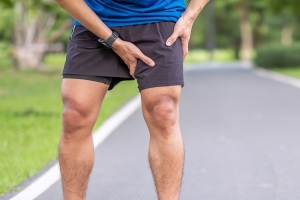A groin strain is not considered a severe injury, but it can cause pain and loss of muscle strength to the person who sustained it. When you have groin strain, you will feel pain and tenderness in the groin and the inner thigh. The discomfort may increase when you bring your legs together or raise your knee. You may also experience swelling and bruising in the groin area, muscle spasms and difficulty walking.
Groin strains are categorized into three stages of severity:
- Grade 1: You will experience mild pain and a little loss of strength.
- Grade 2: Expect moderate pain due to minor damage to muscle tissues.
- Grade 3: Here, you will experience severe pain and loss of function due to a complete tear in the muscle.
How Do You Pull a Groin Muscle
The groin muscle group connects the pubic bone to the top of the thigh and inside the knee. It plays an integral part in pelvic rotational control and hip stability. Therefore, any injuries to these muscles can significantly impede one's movements. But how do you pull a groin muscle?
Groin muscle strains occur when a person places too much stress on the muscles in the groin and thigh. This injury is common to those who engage in sports that involve running or jumping, like football and hockey. In addition, extreme stretching like those done in martial arts, gymnastics and ballet can also cause groin muscle pulls.
However, groin strains can also happen whenever a person performs activities where the muscles are tensed too suddenly or forcefully, like when you lift heavy objects or when you fall from a height.
If you have experienced this injury, you might wonder what to do for a pulled groin muscle. The good news is groin strains are treatable under the supervision of a medical professional.
How To Treat a Pulled Groin Muscle
The first step in knowing how to treat a pulled groin muscle is to undergo a proper diagnosis. While the injury is usually self-apparent since most people know what the damage is the moment it occurs, it's still important to undergo some tests to rule out other possibilities. This is because other afflictions mimic the symptoms of groin strains but require different treatments. Such conditions include a sports hernia, hip labral tear, osteitis pubis, osteoarthritis of the hip and referred groin pain.
The tests depend on the severity of the strain but often involve X-rays and MRIs (magnetic resonance imaging). These evaluations allow your doctor to visualize stress fractures and tissue injuries, enabling them to develop a suitable treatment plan for your condition.
A few days after the injury, the main goal is to reduce the pain and swelling. Doctors will most likely recommend rest, compression and elevation. They may also prescribe anti-inflammatory drugs if you need them. Additional treatments may be necessary to ensure a successful and speedy recovery, including massage therapy, physical therapy or surgery.
How Long Does It Take To Fully Recover From a Groin Strain
The recovery time for groin muscle pulls is approximately two to three weeks. However, it may take longer if your injury is extreme. Third-degree strains usually take four to six months or longer to fully heal. You might be tempted to get back to your normal level of physical activity before the strain is recovered but doing so increases your chances of re-injury. So it is vital to follow the doctor's recommendations.
Can Women Pull a Groin Muscle
Everyone can experience groin strain as long as they are capable of movement. Therefore, if you're wondering, “Can women pull a groin muscle?” the answer is yes. However, groin pain in women can also be a symptom of an ovarian cyst, so it's essential to consult your doctor and undergo all the necessary testing to rule out this possibility.
Preventing Groin Muscle Pulls
The best way to prevent strains on any muscle is through proper conditioning. If you are about to perform an intense physical activity, it's crucial to do stretches first to warm up your muscles. It also helps to keep muscles strong through regular exercise and a gentle stretching routine. This is especially helpful during colder months when muscles are more prone to strains due to low temperatures.
Consult the Experts at American Hip Institute
Being unsure of what to do for a pulled groin muscle is normal since an injury is often an overwhelming experience. However, with the guidance of experienced specialists, your recovery journey becomes much faster and easier. Once you feel pain in your groin area, you should immediately consult reputable hip doctors to diagnose your condition and determine the most suitable treatment plans.
Here at American Hip Institute, we offer advanced treatment for various hip conditions. Whether you have a mild or severe strain, our doctors can accurately diagnose and provide a variety of surgical and non-surgical hip treatments to help regain your strength and movement. Contact us for an appointment today!

